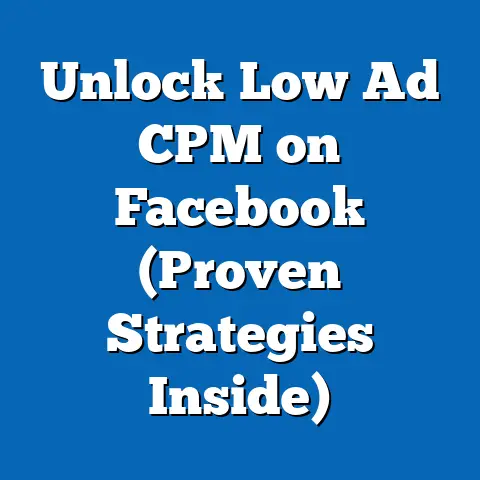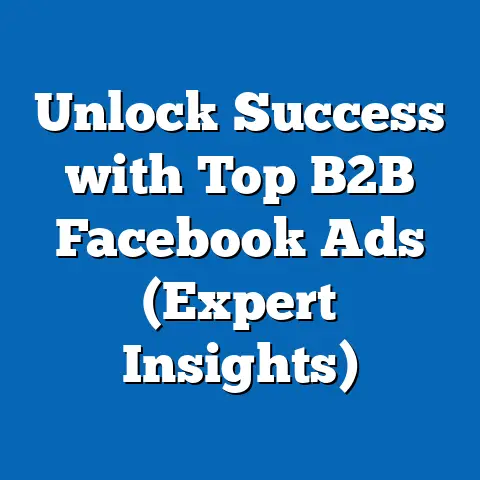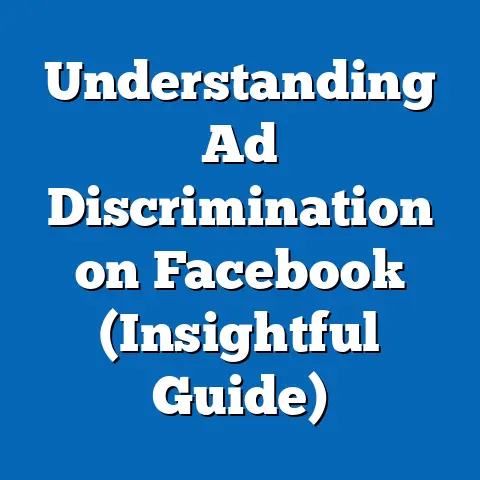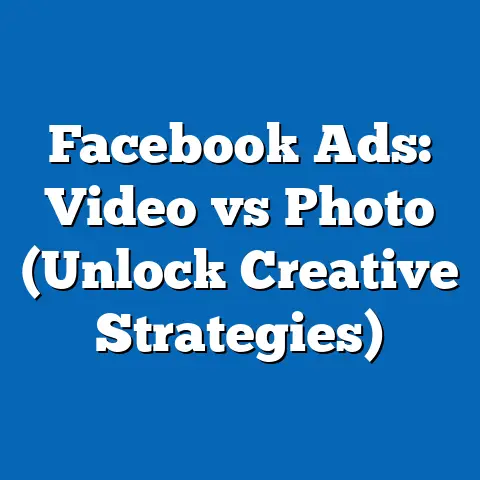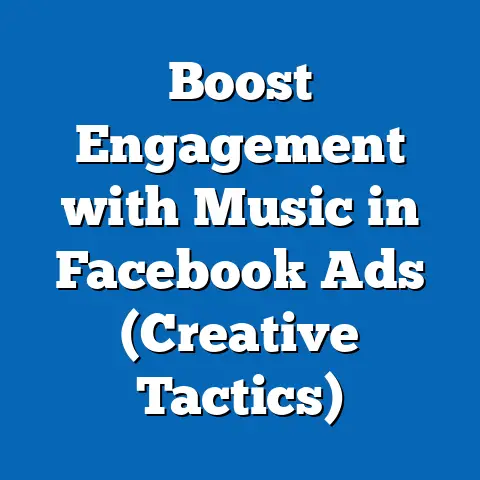Optimize Facebook Ad Size (Maximize Engagement Now)
In today’s digital age, where attention spans are shorter than ever, visual appeal is paramount. And when it comes to Facebook advertising, getting your ad size right is no longer optional – it’s essential. I’ve seen countless campaigns flounder simply because the ad wasn’t visually optimized for the platform. Think of it like this: you wouldn’t wear a suit that’s three sizes too big, would you? The same principle applies to your Facebook ads. They need to fit perfectly to make a lasting impression.
Optimizing your Facebook ad size isn’t just about aesthetics; it’s about performance. A well-sized ad can significantly improve user experience, leading to higher engagement rates, better click-through rates (CTR), and ultimately, more conversions. This guide is designed to walk you through the nuances of Facebook ad sizes, providing you with actionable strategies to maximize your campaign’s potential. Let’s dive in and transform your ads from wallflowers into showstoppers!
Section 1: Understanding Facebook Ad Sizes
Facebook offers a variety of ad formats, each designed to achieve different marketing goals. Understanding the specific size requirements for each format is the first step towards creating visually compelling and effective ads. Let’s break down the most common formats:
Carousel Ads
Carousel ads are perfect for showcasing multiple products or features within a single ad. They allow users to scroll through a series of images or videos, each with its own headline, description, and link.
- Recommended Image Size: 1080 x 1080 pixels
- Recommended Video Size: 1080 x 1080 pixels
- Aspect Ratio: 1:1 (square)
- File Type: JPG or PNG for images, MP4 or MOV for videos
- Description Length: Up to 90 characters
I’ve personally used carousel ads to highlight different aspects of a new product launch, and the results were fantastic. By showcasing various features and benefits in a visually engaging format, we saw a significant boost in click-through rates compared to single-image ads.
Single Image Ads
Single image ads are the most straightforward format, featuring a single image or graphic with accompanying text. They’re ideal for promoting a specific product, service, or offer.
- Recommended Image Size: 1200 x 628 pixels
- Aspect Ratio: 1.91:1
- File Type: JPG or PNG
- Text Length: Up to 125 characters
A common mistake I see is using low-resolution images for single image ads. This can make your ad look unprofessional and deter users from clicking. Always use high-quality images that are properly sized to avoid pixelation or distortion.
Video Ads
Video ads are incredibly powerful for capturing attention and conveying complex messages in a short amount of time. They can be used to tell stories, demonstrate product features, or simply entertain your audience.
- Recommended Video Size: 1080 x 1080 pixels (square), 1080 x 1350 (vertical)
- Aspect Ratio: 1:1 (square), 4:5 (vertical), 16:9 (landscape)
- File Type: MP4 or MOV
- Video Length: Up to 240 minutes (but shorter videos tend to perform better)
I’ve found that shorter video ads, around 15-30 seconds, tend to be the most effective. They’re long enough to convey your message but short enough to keep users engaged. Also, remember to optimize your video for mobile viewing, as most Facebook users access the platform on their smartphones.
Slideshow Ads
Slideshow ads are a cost-effective way to create engaging video-like content using a series of still images. They’re perfect for businesses that don’t have the resources to produce high-quality video ads.
- Recommended Image Size: 1280 x 720 pixels
- Aspect Ratio: 16:9, 1:1, or 2:3
- File Type: JPG or PNG
- Number of Images: 3-7 recommended
Slideshow ads are a great option for businesses on a budget. I once helped a small local restaurant create a slideshow ad showcasing their most popular dishes, and it drove a significant increase in foot traffic to their establishment.
Collection Ads
Collection ads are designed for e-commerce businesses, allowing them to showcase a catalog of products in a visually appealing format. They typically feature a hero image or video, followed by a grid of product images.
- Recommended Image Size: 1200 x 628 pixels (hero image), 600 x 600 pixels (product images)
- Recommended Video Size: 1200 x 628 pixels (hero video)
- Aspect Ratio: 1.91:1 (hero image/video), 1:1 (product images)
- File Type: JPG or PNG for images, MP4 or MOV for videos
Collection ads are a game-changer for e-commerce businesses. I’ve seen them drive significant increases in sales by allowing users to browse a selection of products directly within the Facebook app.
Key Takeaway: Understanding the specific size requirements for each Facebook ad format is crucial for creating visually appealing and effective ads. Always refer to Facebook’s official guidelines for the most up-to-date specifications.
Section 2: The Psychology of Ad Size and Engagement
Ad size isn’t just about technical specifications; it’s deeply intertwined with the psychology of visual perception and engagement. How users perceive your ad can be significantly influenced by its size, layout, and overall visual hierarchy.
Visual Hierarchy and Clarity
Visual hierarchy refers to the arrangement of elements in a way that guides the viewer’s eye to the most important information first. In the context of Facebook ads, this means ensuring that your key message, call-to-action, and branding are immediately noticeable.
The size of your ad plays a crucial role in establishing visual hierarchy. Larger ads tend to command more attention, allowing you to highlight key elements more effectively. However, size isn’t everything. Clarity is equally important. A large, cluttered ad can be just as ineffective as a small, poorly designed one.
I’ve learned that simplicity often wins. A clean, well-organized ad with a clear visual hierarchy can be far more effective than a visually complex one, regardless of size.
Demographic Responses
Different demographics may respond differently to varying ad sizes and formats. For example, younger audiences may be more receptive to visually dynamic video ads, while older audiences may prefer simpler image ads with clear messaging.
Understanding your target audience’s preferences is essential for optimizing your ad size and format. A/B testing different ad variations can help you identify what resonates best with your specific demographic.
I once ran a campaign targeting two different age groups: 18-25 and 35-45. We used the same creative assets but varied the ad size and format. The younger audience responded much better to vertical video ads, while the older audience preferred square image ads. This insight allowed us to tailor our campaign for each demographic, resulting in a significant increase in engagement.
Branding and Consistency
Your ad size should also align with your overall branding strategy. Maintaining consistency in visual style, messaging, and branding across all your ads is crucial for building brand recognition and trust.
If your brand is known for its minimalist aesthetic, a cluttered or overly complex ad may feel out of place. Conversely, if your brand is known for its bold and dynamic visuals, a small, understated ad may not capture the essence of your brand.
I always advise clients to create a style guide that outlines their brand’s visual identity, including preferred ad sizes, colors, fonts, and imagery. This ensures consistency across all marketing materials, including Facebook ads.
Key Takeaway: Ad size is not just a technical consideration; it’s a psychological one. Understanding how ad size influences visual perception, demographic responses, and branding is essential for creating engaging and effective Facebook ads.
Section 3: Best Practices for Optimizing Facebook Ad Size
Now that we understand the importance of ad size and its psychological impact, let’s dive into some practical tips for optimizing your Facebook ad size.
Step-by-Step Guide to Creating Optimized Ads
- Define Your Marketing Goal: What do you want to achieve with your ad? Are you trying to drive traffic to your website, generate leads, or increase sales? Your marketing goal will influence the type of ad format you choose and the size of your ad.
- Identify Your Target Audience: Who are you trying to reach with your ad? Understanding your target audience’s demographics, interests, and behaviors will help you create ads that resonate with them.
- Choose the Right Ad Format: Based on your marketing goal and target audience, select the ad format that is most likely to achieve your desired results.
- Create High-Quality Visuals: Use high-resolution images or videos that are properly sized for the chosen ad format. Avoid using blurry or pixelated images, as they can detract from the overall visual appeal of your ad.
- Write Compelling Copy: Craft clear, concise, and engaging copy that highlights the key benefits of your product or service. Use a strong call-to-action to encourage users to take the desired action.
- A/B Test Different Ad Sizes: Experiment with different ad sizes to see what resonates best with your target audience. Use Facebook Ads Manager to track the performance of each ad variation and identify the most effective size.
- Monitor and Optimize: Continuously monitor the performance of your ads and make adjustments as needed. Pay attention to metrics such as click-through rate (CTR), conversion rate, and cost per acquisition (CPA) to identify areas for improvement.
A/B Testing Ad Sizes
A/B testing is a crucial part of optimizing your Facebook ad size. By creating multiple variations of your ad with different sizes, you can determine which size performs best with your target audience.
When A/B testing ad sizes, make sure to keep all other variables constant, such as the ad copy, visuals, and targeting options. This will ensure that you’re accurately measuring the impact of ad size on performance.
I recommend running A/B tests for at least a week to gather enough data to make informed decisions. Use Facebook Ads Manager to track the performance of each ad variation and identify the winning size.
Tools and Software
Several tools and software can assist you in designing ads with the correct dimensions. Some popular options include:
- Canva: A user-friendly graphic design tool that offers pre-sized templates for Facebook ads.
- Adobe Photoshop: A professional-grade image editing software that allows you to create and resize images with precision.
- Adobe Premiere Pro: A professional-grade video editing software that allows you to create and edit videos for Facebook ads.
- Facebook Ads Manager: Facebook’s built-in ad creation tool, which provides specifications for each ad format.
I personally use Canva for creating quick and easy Facebook ads. It’s incredibly user-friendly and offers a wide range of templates and design elements. For more complex ad designs, I turn to Adobe Photoshop.
Maintaining Quality When Resizing
Resizing images and videos can sometimes lead to a loss of quality. To avoid this, follow these tips:
- Start with High-Resolution Assets: Always start with high-resolution images and videos to ensure that they maintain their quality when resized.
- Use the Correct Aspect Ratio: Make sure to use the correct aspect ratio for the chosen ad format. This will prevent your images or videos from being distorted or cropped.
- Avoid Over-Compression: Over-compressing images and videos can lead to a loss of quality. Use the appropriate compression settings to maintain a balance between file size and visual quality.
- Preview Your Ads: Always preview your ads on different devices to ensure that they look good on all screen sizes.
Key Takeaway: Optimizing your Facebook ad size requires a combination of technical knowledge, creative design, and data-driven decision-making. By following these best practices, you can create ads that are visually appealing, engaging, and effective.
Section 4: Analyzing Performance Metrics Related to Ad Size
Optimizing your ad size is only half the battle. You also need to track and analyze the performance of your ads to determine whether your efforts are paying off. Here are some key performance indicators (KPIs) to monitor:
Key Performance Indicators (KPIs)
- Click-Through Rate (CTR): The percentage of users who click on your ad after seeing it. A higher CTR indicates that your ad is resonating with your target audience.
- Conversion Rate: The percentage of users who take the desired action after clicking on your ad, such as making a purchase or filling out a form. A higher conversion rate indicates that your ad is effectively driving conversions.
- Cost Per Click (CPC): The amount you pay each time someone clicks on your ad. A lower CPC indicates that your ad is cost-effective.
- Cost Per Acquisition (CPA): The amount you pay to acquire a new customer or lead through your ad. A lower CPA indicates that your ad is efficiently driving new business.
- Engagement Rate: The percentage of users who interact with your ad, such as liking, commenting, or sharing it. A higher engagement rate indicates that your ad is capturing attention and generating interest.
Interpreting Data
Analyzing your ad performance data can provide valuable insights into the effectiveness of your ad size. For example, if you notice that your CTR is low, it could indicate that your ad is not visually appealing or that your targeting is not accurate. If your conversion rate is low, it could indicate that your landing page is not optimized or that your offer is not compelling.
By carefully analyzing your ad performance data, you can identify areas for improvement and make adjustments to your ad size, visuals, copy, or targeting to optimize your results.
I always tell clients to focus on the metrics that matter most to their business goals. If you’re trying to drive sales, focus on conversion rate and CPA. If you’re trying to build brand awareness, focus on engagement rate and reach.
Using Facebook Ads Manager
Facebook Ads Manager provides a wealth of data and analytics to help you track and analyze the performance of your ads. You can use Ads Manager to monitor your KPIs, track your spending, and identify areas for improvement.
Ads Manager also offers a variety of reporting tools that allow you to segment your data by demographics, interests, and behaviors. This can help you gain a deeper understanding of your target audience and optimize your ads accordingly.
I recommend spending time familiarizing yourself with Facebook Ads Manager and its various features. It’s an invaluable tool for optimizing your Facebook ad campaigns.
Case Studies
Let’s look at a few case studies of businesses that successfully analyzed and adjusted their ad sizes for improved engagement:
- E-commerce Retailer: An e-commerce retailer noticed that their carousel ads were performing poorly compared to their single image ads. After analyzing their data, they discovered that users were not scrolling through all the images in the carousel. They decided to switch to single image ads with a clear call-to-action, which resulted in a significant increase in conversion rate.
- Local Restaurant: A local restaurant was struggling to drive foot traffic to their establishment. They decided to run a video ad showcasing their most popular dishes. After analyzing their data, they discovered that shorter video ads were performing better than longer ones. They shortened their video ad to 15 seconds, which resulted in a significant increase in foot traffic.
- Software Company: A software company was trying to generate leads through Facebook ads. They decided to run a lead generation ad with a form embedded directly within the ad. After analyzing their data, they discovered that users were not filling out the form. They decided to simplify the form and reduce the number of fields, which resulted in a significant increase in lead generation.
Key Takeaway: Analyzing your ad performance data is crucial for optimizing your Facebook ad size and achieving your marketing goals. By monitoring your KPIs, interpreting your data, and using Facebook Ads Manager, you can identify areas for improvement and make adjustments to your ads to maximize your results.
Section 5: Case Studies of Successful Facebook Ad Campaigns
Let’s examine some real-world examples of brands that have effectively optimized their Facebook ad sizes to enhance engagement and achieve their marketing objectives.
Case Study 1: Nike – “Just Do It” Campaign
Nike is a master of visual storytelling, and their “Just Do It” campaign on Facebook is a prime example of how to use ad size to your advantage. They often use high-quality video ads in a vertical format (4:5 aspect ratio), which is perfect for mobile viewing.
- Strategy: Nike uses a combination of visually stunning imagery and inspiring messaging to capture attention and motivate users to take action.
- Ad Size: Vertical video ads (4:5 aspect ratio)
- Results: High engagement rates, increased brand awareness, and a positive brand image.
- Lessons Learned: Use high-quality visuals, tell a compelling story, and optimize for mobile viewing.
I’ve always admired Nike’s ability to connect with their audience on an emotional level. Their ads are not just about selling products; they’re about inspiring people to achieve their goals.
Case Study 2: Sephora – Product Showcase
Sephora uses carousel ads to showcase a variety of products and drive traffic to their website. They use high-quality images and clear product descriptions to entice users to click through and make a purchase.
- Strategy: Sephora uses carousel ads to showcase multiple products and highlight their key features and benefits.
- Ad Size: Square images (1:1 aspect ratio)
- Results: Increased website traffic, higher conversion rates, and improved sales.
- Lessons Learned: Use high-quality images, write clear product descriptions, and offer a compelling call-to-action.
I’ve noticed that Sephora’s ads are always visually appealing and well-organized. They make it easy for users to browse their products and find what they’re looking for.
Case Study 3: Airbnb – Travel Inspiration
Airbnb uses single image ads to inspire users to travel and book accommodations. They use stunning landscape photography and compelling copy to create a sense of wanderlust.
- Strategy: Airbnb uses single image ads to showcase unique travel destinations and inspire users to book accommodations.
- Ad Size: Landscape images (1.91:1 aspect ratio)
- Results: Increased website traffic, higher booking rates, and improved brand awareness.
- Lessons Learned: Use stunning visuals, write compelling copy, and target users with a passion for travel.
I’ve been captivated by Airbnb’s ads on numerous occasions. They always manage to showcase the beauty and wonder of travel in a way that makes me want to book a trip.
Key Takeaway: These case studies demonstrate the importance of optimizing your Facebook ad size to enhance engagement and achieve your marketing goals. By using high-quality visuals, writing compelling copy, and targeting your ads effectively, you can create campaigns that resonate with your target audience and drive results.
Section 6: Future Trends in Facebook Ad Sizes
The world of digital advertising is constantly evolving, and Facebook ad sizes are no exception. As technology advances and user behavior changes, we can expect to see new ad formats and size requirements emerge.
Augmented Reality (AR) Ads
Augmented reality (AR) ads are an emerging trend that allows users to interact with products in a virtual environment. For example, a furniture retailer could allow users to see how a sofa would look in their living room using AR technology.
AR ads require specific size and format requirements, which are still evolving. However, they offer a unique and engaging way to connect with your audience.
I believe that AR ads have the potential to revolutionize the way we shop online. By allowing users to virtually try before they buy, AR ads can significantly increase conversion rates and reduce returns.
Artificial Intelligence (AI) Optimization
Artificial intelligence (AI) is increasingly being used to optimize Facebook ad campaigns. AI algorithms can analyze vast amounts of data to identify the most effective ad sizes, visuals, copy, and targeting options.
AI-powered ad optimization tools can help you automate your ad campaigns and achieve better results with less effort.
I’m excited about the potential of AI to transform the way we approach Facebook advertising. By leveraging AI technology, we can create more personalized and effective ad campaigns that drive results.
Changing User Behavior
As user behavior on Facebook continues to evolve, ad sizes and formats will need to adapt to meet the changing needs of users. For example, as more users access Facebook on their mobile devices, vertical video ads are likely to become even more popular.
Staying up-to-date on the latest trends in user behavior is essential for optimizing your Facebook ad campaigns.
I always encourage clients to stay curious and experiment with new ad formats and sizes. The key to success in Facebook advertising is to be adaptable and willing to try new things.
Key Takeaway: The future of Facebook ad sizes is likely to be shaped by emerging technologies such as AR and AI, as well as changing user behavior. Staying up-to-date on the latest trends and adapting your ad strategy accordingly is essential for achieving long-term success.
Conclusion
In the ever-evolving landscape of social media marketing, optimizing your Facebook ad size is not just a best practice; it’s a necessity. By understanding the different ad formats, the psychology of visual engagement, and the importance of data-driven decision-making, you can create ads that capture attention, resonate with your target audience, and drive results.
Remember, the right ad size can make a significant difference in your campaign’s success. So, take the insights provided in this guide and start experimenting with different ad sizes to find what works best for your business. Don’t be afraid to try new things and adapt your strategy as needed.
The world of Facebook advertising is constantly changing, but one thing remains constant: the importance of creating visually compelling and engaging ads. By optimizing your ad size, you can ensure that your ads stand out from the crowd and make a lasting impression on your target audience.
Now, go out there and create some amazing Facebook ads! I’m confident that with the knowledge and strategies you’ve gained from this guide, you’ll be well on your way to achieving your marketing goals. Good luck!

